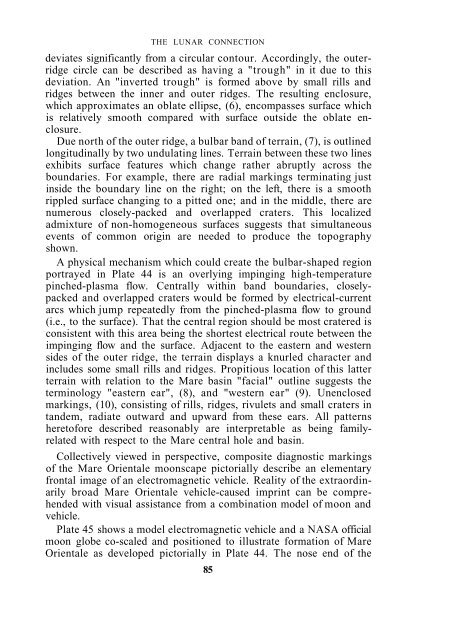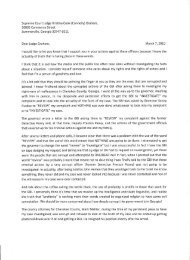Ringmakers of Saturn PDF - Patrick Crusade
Ringmakers of Saturn PDF - Patrick Crusade
Ringmakers of Saturn PDF - Patrick Crusade
Create successful ePaper yourself
Turn your PDF publications into a flip-book with our unique Google optimized e-Paper software.
THE LUNAR CONNECTION<br />
deviates significantly from a circular contour. Accordingly, the outerridge<br />
circle can be described as having a "trough" in it due to this<br />
deviation. An "inverted trough" is formed above by small rills and<br />
ridges between the inner and outer ridges. The resulting enclosure,<br />
which approximates an oblate ellipse, (6), encompasses surface which<br />
is relatively smooth compared with surface outside the oblate enclosure.<br />
Due north <strong>of</strong> the outer ridge, a bulbar band <strong>of</strong> terrain, (7), is outlined<br />
longitudinally by two undulating lines. Terrain between these two lines<br />
exhibits surface features which change rather abruptly across the<br />
boundaries. For example, there are radial markings terminating just<br />
inside the boundary line on the right; on the left, there is a smooth<br />
rippled surface changing to a pitted one; and in the middle, there are<br />
numerous closely-packed and overlapped craters. This localized<br />
admixture <strong>of</strong> non-homogeneous surfaces suggests that simultaneous<br />
events <strong>of</strong> common origin are needed to produce the topography<br />
shown.<br />
A physical mechanism which could create the bulbar-shaped region<br />
portrayed in Plate 44 is an overlying impinging high-temperature<br />
pinched-plasma flow. Centrally within band boundaries, closelypacked<br />
and overlapped craters would be formed by electrical-current<br />
arcs which jump repeatedly from the pinched-plasma flow to ground<br />
(i.e., to the surface). That the central region should be most cratered is<br />
consistent with this area being the shortest electrical route between the<br />
impinging flow and the surface. Adjacent to the eastern and western<br />
sides <strong>of</strong> the outer ridge, the terrain displays a knurled character and<br />
includes some small rills and ridges. Propitious location <strong>of</strong> this latter<br />
terrain with relation to the Mare basin "facial" outline suggests the<br />
terminology "eastern ear", (8), and "western ear" (9). Unenclosed<br />
markings, (10), consisting <strong>of</strong> rills, ridges, rivulets and small craters in<br />
tandem, radiate outward and upward from these ears. All patterns<br />
heret<strong>of</strong>ore described reasonably are interpretable as being familyrelated<br />
with respect to the Mare central hole and basin.<br />
Collectively viewed in perspective, composite diagnostic markings<br />
<strong>of</strong> the Mare Orientale moonscape pictorially describe an elementary<br />
frontal image <strong>of</strong> an electromagnetic vehicle. Reality <strong>of</strong> the extraordinarily<br />
broad Mare Orientale vehicle-caused imprint can be comprehended<br />
with visual assistance from a combination model <strong>of</strong> moon and<br />
vehicle.<br />
Plate 45 shows a model electromagnetic vehicle and a NASA <strong>of</strong>ficial<br />
moon globe co-scaled and positioned to illustrate formation <strong>of</strong> Mare<br />
Orientale as developed pictorially in Plate 44. The nose end <strong>of</strong> the<br />
85



